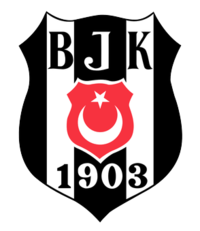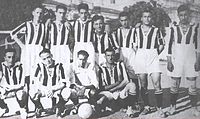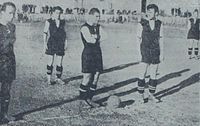19 Mayıs 2016 Perşembe
Jandarma 19 Mayıs Atatürk'ü Anma Gençlik ve Spor Bayramı Klibi
https://www.youtube.com/watch?v=0QSp3fa-yGs
15 Mayıs 2016 Pazar
https://www.youtube.com/watch?v=_XM97dEWFtI
Beşiktaş J.K.
"BJK" redirects here. For other uses, see BJK (disambiguation).
 |
||||
| Full name | Beşiktaş Jimnastik Kulübü[1] | |||
|---|---|---|---|---|
| Nickname(s) | Kara Kartallar (Black Eagles)[2][3] Siyah Beyazlılar (Black and Whites) |
|||
| Founded | 19 March 1903; 113 years ago,[1] as Beşiktaş Bereket Jimnastik Kulübü[4] |
|||
| Ground | Vodafone Arena Istanbul, Turkey |
|||
| Capacity | 41,903 | |||
| Chairman | Fikret Orman[5] | |||
| Manager | Şenol Güneş | |||
| League | Süper Lig | |||
| 2015–16 | Süper Lig, 1st | |||
| Website | Club home page | |||
|
|
||||
The club's football team is one of the most successful teams in Turkey, having never been relegated to a lower division. The club last won the Turkish Süper Lig championship during the 2008–09 season, achieving a "double" after also winning the Turkish Cup[6] in the same season.
The home ground of Beşiktaş was the İnönü Stadium with a seating capacity of 32,086, however the ground was demolished in order for the Vodafone Arena to be constructed on the same land.
The club also competes in other branches including basketball, volleyball, handball, athletics, boxing, wrestling, chess, bridge, gymnastics, rowing, table tennis, paralympic sports, eSports and beach football.[7]
History
| Active departments of Beşiktaş | ||
|---|---|---|
| Football (Men's) | Football (Women's) | Handball (Men's) |
| Basketball (Men's) | Basketball (Women's) | Wheelchair Basketball |
| Volleyball (Men's) | Volleyball (Women's) | Table tennis |
| Athletics | Boxing | Wrestling |
| Rowing | Bridge | Chess |
| Gymnastics | eSports | |
Early years
Beşiktaş was established in 1903 during the late Ottoman period. A group of 22 young individuals gathered on certain days of the week to perform bodily exercises in the Serencebey neighborhood of Beşiktaş. They began in the fall of 1902, in the garden of the mansion of Osman Paşa, who was then a part of the Medine Guard. The various sporting activities that these youths participated in included the horizontal bar, parallel bar, wrestling, weight lifting and gymnastics. They included such members as the sons of Osman Paşa, Mehmet Şamil and Hüseyin Bereket, and other youths of the neighborhood – Ahmet Fetgeri, Mehmet Ali Fetgeri, Nazım Nazif, Cemil Feti and Şevket. At that time, the Sultan Abdul Hamid II was having secret agents go around the city, reporting on any gatherings that might be political in nature. When these agents heard about the group, a raid was conducted and the exercising youths were taken to the police station. The tense situation was relaxed as some of these youths were close to palace officers. Since football was in disfavor in those days, they only participated in bodily exercises. In fact, Şehzade Abdülhalim, who had relations with the Palace, supported these youths and started to watch their practices frequently. Famous boxer and wrestler Kenan Bey came to the practices and started to show the group wrestling and boxing tricks.
Beşiktaş in 1903
In the meantime, Beşiktaş Ottoman Gymnastics Club became the first registered Turkish sports club on 13 January 1910 with the encouragement of Beyoğlu Governor Muhittin Bey. The interest among the youths of the neighborhood in the sports club grew and the number of members involved in sports suddenly went up to 150. The headquarters of the club was moved from Ihlamur to Building 49 in Akaretler. When this building became too small, Building 84, also in Akaretler, became their headquarters. The yard behind this building was turned into a sports pitch.
Some of the young patriots from the Beşiktaş district of Istanbul formed two football clubs called "Valideçeşme" and "Basiret" under the leadership of Şeref Bey. The Valideçeşme and Basiret football clubs joined under the Beşiktaş Ottoman Gymnastics Club in 1911. In a very short time, football became the foremost branch in the club.
For years, the original colours of the Beşiktaş were believed to be Red and White; and then temporarily changed into Black and White as a sign of mourning for the dead in Balkan Wars, which included some players of the club. Although most written sources endorse this claim, a detailed study carried out for Beşiktaş’s 100th anniversary documentary had shown that red was never used in club’s first colors; and Beşiktaş’s colours were always Black and White.[8]
Initial years of football
1923–24 Istanbul League champions
Players of Beşiktaş before the match against Galatasaray, 19 March 1939.
Beşiktaş won their second Istanbul League championship in 1934, as well as their first Turkish Football Championship in the same year. In 1937, the Turkish National League was formed. In the Istanbul League season prior to the National League's first season, Beşiktaş finished in 4th place, which earned them a berth in the National League. Beşiktaş finished 3rd place in the National league behind Fenerbahçe and Galatasaray. In 1938 Beşiktaş finished 3rd place in the Istanbul league and 2nd place in the National league behind Güneş. Beşiktaş won a record 5 consecutive Istanbul league championships between 1939 and 1943. In the National league Beşiktaş finished 4th in 1939, 5th in 1940, 1st in 1941 and 3rd in 1943 (1942 league was not held). Beşiktaş won the Istanbul league in 1945 and 1946, as well as the National league in 1944, and 1947.
After 1959
In 1959 the Turkish First League was formed. It was Turkey's first professional league. Beşiktaş came in 3rd place in the inaugural year of the league. Beşiktaş won the league title in 1960. In 1960 they also took part in the European Cup, and became the first Turkish team ever to participate in that cup. Beşiktaş finished in 3rd place in 1961 and 1962 and 2nd place in 1963, 1964 and 1965. After that, their consistency paid off and they were finally champions again in 1966 and 1967. In 1967, they also won their first Turkish Super Cup. In 1968, Beşiktaş finished in 2nd place.Silent 1970s
After 1967, Beşiktaş's performance declined slightly, finishing in 8th, 12th, 5th, 4th many times, while Trabzonspor, Fenerbahçe and Galatasaray continued their success. Beşiktaş only finished 2nd place once in the decade (1975).1980s Revival
Beşiktaş put an end to their bad performance in 1982 with a surprise Turkish championship. Beşiktaş got another championship in 1986 as well. They finished the league in the second place four times in the second half of the decade except the championship in 1985–86 season. Hooliganism was also a major problem that had started in Europe and spread throughout Turkey as well. Beşiktaş fan hooliganism had been a major issue with many fights inside and outside the stadium. However this has become less of an issue more recently.Gordon Milne era: 1987–1993
Main article: Metin-Ali-Feyyaz
Beşiktaş had their most successful run in the Süper Lig with three consecutive championships under the management of Gordon Milne in the early 90s. Three players of the squad; Metin Tekin, Ali Gültiken, and Feyyaz Uçar were notable for significant contributions to the team during this period. These players had been called Metin-Ali-Feyyaz
("MAF") and they formed the front of the team's line-up. The supporters
composed various chants for the trio devoted to their delighting style
on the pitch, their goals, and above all for their friendship and
modesty. The trio is regarded by supporters as the best ever attacking
line of the club.The only three-in-a-row title term in club history occurred in the 1989–90, 1990–91 and 1991–92 seasons. Most notably, Beşiktaş became the first undefeated champion in Süper Lig history.[9][10] So far, Beşiktaş is the only team that has achieved these honors.
Under Milne, the team adopted the 4–4–2 system. By playing down the lines, crossing, and winning balls in the air, the team scored many goals. On 15 October 1989, Beşiktaş broke the Süper Lig record for the biggest winning margin in a game with a 10–0 victory over Southern Turkey team Adana Demirspor.[11] This match was designated as one of the 16 biggest matches in club history.[12]
Legend of the Black Eagles
There is a legend surrounding the nicknaming of the team as "The Black Eagles." Beşiktaş, the title holder of the previous two seasons started the 1940–41 season with a young and renewed team. As the weeks went by, this team was more and more secure in the leader's seat in the league. With five weeks remaining in the season, the opponent was Süleymaniye. Beşiktaş had started the game in Şeref Stadium on Sunday 19 January 1941, with the following players: Faruk, Yavuz, İbrahim, Rıfat, Halil, Hüseyin, Şakir, Hakkı, Şükrü, Şeref, Eşref. The team went ahead in the first half. Halfway through the second half of the game, Beşiktaş attacked continuously, despite being in front. And then, according to legend, a voice was heard from the stands towards which Beşiktaş was attacking. The voice said "Come on, Black Eagles! Attack, Black Eagles!" The story goes that the owner of the voice from the stands was a fisherman called Mehmet Galin. Beşiktaş finished the game with a 6–0 win. The Beşiktaş players, who had very successfully defeated their opponents that season, were being described as "Black Eagles", and the football they played was being compared to "Attacking like Black Eagles". The comparison resonated with the team and the fans, and so it was adopted by the Beşiktaş community as their team's nickname.[13]Colours and badge
BJK İnönü Stadium entrance, displaying the club emblem and stars for Turkish Super League championships.
The date Beşiktaş’s first badge was made was written as “1906” in Latin years inspired by the badges in the French school. On top, it said “Beşiktaş” in Arabic letters, the letter “J” was placed on the rights and letter “K” was placed on the left. On the back of the badge, there was a script saying it was made in Constantinople and there was the seal of the craftsmen who made the badge on the inside. It is interesting that the star on the crest on the badge has 6 points. This 6-pointed star was used until the 2nd Constitutional Monarchy (1908). This badge was donated by Iskender Yakak to Süleyman Seba, the late Honorary President of Beşiktaş J.K.
The current emblem of Beşiktaş symbolizes the foundation date. There are two white and three black bars on the emblem. It consists of nine parts in total. There is one white bar, three black bars, and another white bar, and there are nine parts in total. Thus: 1319, the year of the club's foundation. (The Islamic calendar was still used in the Ottoman Empire at the time of the club's foundation. 1319 is the equivalent of 1903 in Gregorian Calendar.)
Home colours
Away colours
Third colours
Stadium
Main article: BJK İnönü Stadium
BJK İnönü Stadium in 2009
There were four different parts of the stadium; 1."Kapalı" is where the most hot-blooded fans were during the matches; 2."Yeni Açık" was the larger side, which faced the sea; 3."Eski Açık" was the smaller curve on the seaside, where visiting supporters were typically placed; 4."Numaralı" is where press, VIP and protocol stands could be found.
2013 was the last season of the İnönü Stadium as Beşiktaş's home ground. The club played their 2013-14 and 2014-15 season home games mostly at the Ataturk Olympic Stadium and the Başakşehir Fatih Terim Stadium. The new stadium, Vodafone Arena, has completed in 2016.
Players
Current squad
- As of 19 January 2015.[14]
|
|
Kaydol:
Yorumlar (Atom)






